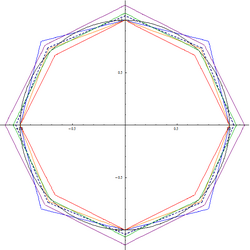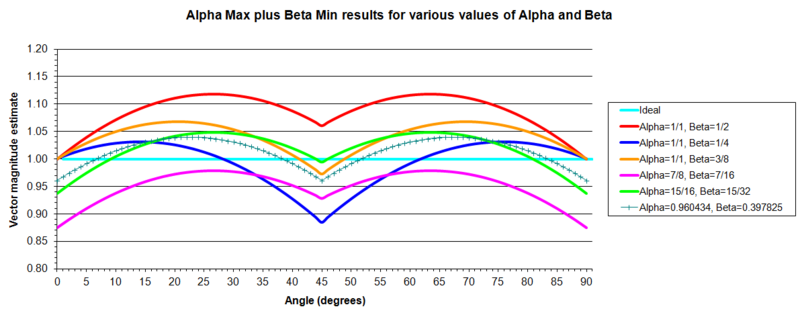Alpha max plus beta min algorithm
The alpha max plus beta min algorithm[1] is a high-speed approximation of the square root of the sum of two squares. The square root of the sum of two squares, also known as Pythagorean addition, is a useful function, because it finds the hypotenuse of a right triangle given the two side lengths, the norm of a 2-D vector, or the magnitude [math]\displaystyle{ |z| = \sqrt{a^2 + b^2} }[/math] of a complex number z = a + bi given the real and imaginary parts.
The algorithm avoids performing the square and square-root operations, instead using simple operations such as comparison, multiplication, and addition. Some choices of the α and β parameters of the algorithm allow the multiplication operation to be reduced to a simple shift of binary digits that is particularly well suited to implementation in high-speed digital circuitry.
The approximation is expressed as [math]\displaystyle{ |z| = \alpha\,\mathbf{Max} + \beta\,\mathbf{Min}, }[/math] where [math]\displaystyle{ \mathbf{Max} }[/math] is the maximum absolute value of a and b, and [math]\displaystyle{ \mathbf{Min} }[/math] is the minimum absolute value of a and b.
For the closest approximation, the optimum values for [math]\displaystyle{ \alpha }[/math] and [math]\displaystyle{ \beta }[/math] are [math]\displaystyle{ \alpha_0 = \frac{2 \cos \frac{\pi}{8}}{1 + \cos \frac{\pi}{8}} = 0.960433870103... }[/math] and [math]\displaystyle{ \beta_0 = \frac{2 \sin \frac{\pi}{8}}{1 + \cos \frac{\pi}{8}} = 0.397824734759... }[/math], giving a maximum error of 3.96%.
| [math]\displaystyle{ \alpha\,\! }[/math] | [math]\displaystyle{ \beta\,\! }[/math] | Largest error (%) | Mean error (%) |
|---|---|---|---|
| 1/1 | 1/2 | 11.80 | 8.68 |
| 1/1 | 1/4 | 11.61 | 3.20 |
| 1/1 | 3/8 | 6.80 | 4.25 |
| 7/8 | 7/16 | 12.50 | 4.91 |
| 15/16 | 15/32 | 6.25 | 3.08 |
| [math]\displaystyle{ \alpha_0 }[/math] | [math]\displaystyle{ \beta_0 }[/math] | 3.96 | 2.41 |
Improvements
When [math]\displaystyle{ \alpha \lt 1 }[/math], [math]\displaystyle{ |z| }[/math] becomes smaller than [math]\displaystyle{ \mathbf{Max} }[/math] (which is geometrically impossible) near the axes where [math]\displaystyle{ \mathbf{Min} }[/math] is near 0. This can be remedied by replacing the result with [math]\displaystyle{ \mathbf{Max} }[/math] whenever that is greater, essentially splitting the line into two different segments.
- [math]\displaystyle{ |z| = \max(\mathbf{Max}, \alpha\,\mathbf{Max} + \beta\,\mathbf{Min}). }[/math]
Depending on the hardware, this improvement can be almost free.
Using this improvement changes which parameter values are optimal, because they no longer need a close match for the entire interval. A lower [math]\displaystyle{ \alpha }[/math] and higher [math]\displaystyle{ \beta }[/math] can therefore increase precision further.
Increasing precision: When splitting the line in two like this one could improve precision even more by replacing the first segment by a better estimate than [math]\displaystyle{ \mathbf{Max} }[/math], and adjust [math]\displaystyle{ \alpha }[/math] and [math]\displaystyle{ \beta }[/math] accordingly.
- [math]\displaystyle{ |z| = \max\big(|z_0|, |z_1|\big), }[/math]
- [math]\displaystyle{ |z_0| = \alpha_0\,\mathbf{Max} + \beta_0\,\mathbf{Min}, }[/math]
- [math]\displaystyle{ |z_1| = \alpha_1\,\mathbf{Max} + \beta_1\,\mathbf{Min}. }[/math]
| [math]\displaystyle{ \alpha_0 }[/math] | [math]\displaystyle{ \beta_0 }[/math] | [math]\displaystyle{ \alpha_1 }[/math] | [math]\displaystyle{ \beta_1 }[/math] | Largest error (%) |
|---|---|---|---|---|
| 1 | 0 | 7/8 | 17/32 | −2.65% |
| 1 | 0 | 29/32 | 61/128 | +2.4% |
| 1 | 0 | 0.898204193266868 | 0.485968200201465 | ±2.12% |
| 1 | 1/8 | 7/8 | 33/64 | −1.7% |
| 1 | 5/32 | 27/32 | 71/128 | 1.22% |
| 127/128 | 3/16 | 27/32 | 71/128 | −1.13% |
Beware however, that a non-zero [math]\displaystyle{ \beta_0 }[/math] would require at least one extra addition and some bit-shifts (or a multiplication), probably nearly doubling the cost and, depending on the hardware, possibly defeat the purpose of using an approximation in the first place.
See also
- Hypot, a precise function or algorithm that is also safe against overflow and underflow.
References
- ↑ Assim, Ara Abdulsatar Assim (2021). "ASIC implementation of high-speed vector magnitude & arctangent approximator" (in en). Computing, Telecommunication and Control 71 (4): 7–14. doi:10.18721/JCSTCS.14401. https://infocom.spbstu.ru/en/article/2021.71.01/.
- Lyons, Richard G. Understanding Digital Signal Processing, section 13.2. Prentice Hall, 2004 ISBN:0-13-108989-7.
- Griffin, Grant. DSP Trick: Magnitude Estimator.
External links
- "Extension to three dimensions". Stack Exchange. May 14, 2015. https://math.stackexchange.com/q/1282435.
 |



